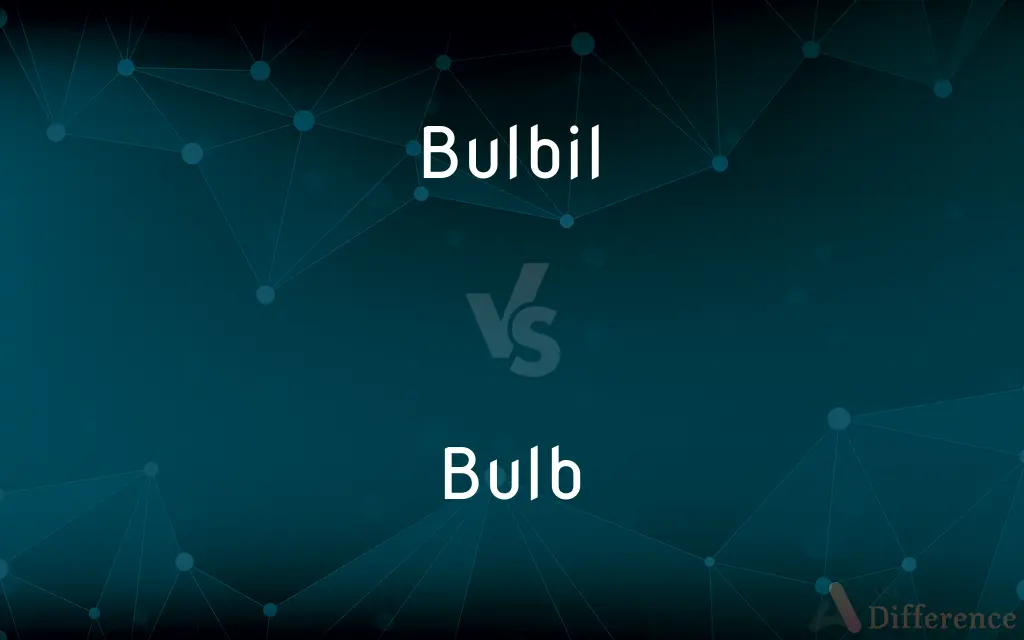Bulbil vs. Bulb — What's the Difference?
By Maham Liaqat & Fiza Rafique — Updated on April 5, 2024
A bulbil is a small bulb-like structure used for asexual reproduction in plants, growing on leaves or flower parts, while a bulb is a storage organ formed from underground stems and leaves, used for sexual and asexual reproduction.

Difference Between Bulbil and Bulb
Table of Contents
ADVERTISEMENT
Key Differences
Bulbils are specialized structures that some plants develop as a means of asexual reproduction. They form on various parts of a plant, such as the axils of leaves or near the flowers, and can grow into new plants when they fall to the ground or are otherwise separated from the parent plant. This method of reproduction allows for the rapid spread of the species without the need for seeds. On the other hand, bulbs are underground storage organs composed of a shortened stem surrounded by fleshy leaves or leaf bases. They serve as a storage unit for nutrients to support the plant during adverse environmental conditions and facilitate both sexual and asexual reproduction through the production of seeds and sometimes offsets, respectively.
Bulbils contribute to the genetic uniformity of a species since the offspring are clones of the parent plant, lacking genetic variation. This can be advantageous in stable environments where the parent plant's characteristics are well-suited to the conditions. Bulbs, however, can give rise to genetically diverse offspring through seed production, enhancing a species' adaptability to changing environments and potential resistance to diseases and pests.
While bulbils are an effective strategy for rapid dispersal and colonization of new areas, they are limited by their reliance on physical processes for dispersal, such as water movement or animals. Bulbs can lead to the dispersal of a plant species over greater distances through seed dispersal mechanisms, such as wind, animals, or water, thereby potentially expanding the plant's geographical range more effectively.
The care and cultivation of plants with bulbils versus those with bulbs can differ significantly. Plants producing bulbils might require strategies to manage their spread in a garden setting, as they can become invasive. Plants grown from bulbs often require specific planting depths and periods of dormancy to ensure successful growth and flowering, reflecting their adaptation to seasonal cycles.
Both bulbils and bulbs play crucial roles in the survival and propagation of plants, yet their functions and contributions to the plant lifecycle and ecosystem vary markedly. Bulbils are part of an asexual reproduction strategy that ensures quick population growth under favorable conditions, while bulbs support both survival through adverse conditions and reproduction.
ADVERTISEMENT
Comparison Chart
Function
Asexual reproduction
Storage; sexual and asexual reproduction
Location
On leaves, stems, or flower parts
Underground
Reproduction Type
Clonal
Can be clonal or involve genetic diversity through seeds
Dispersal Mechanism
Limited to physical means like water or animals
Seeds can be dispersed by wind, animals, or water
Growth Requirement
May require management to prevent invasiveness
Requires specific planting depths and periods of dormancy
Genetic Variation
None; offspring are clones of the parent
Possible through seeds; offspring can have genetic diversity
Environmental Adaptation
Quick colonization of stable environments
Adaptability to changing environments
Compare with Definitions
Bulbil
A small bulb or bulb-like structure used for asexual reproduction in plants.
The lily plant produced several bulbils along its stem.
Bulb
An underground storage organ consisting of a short stem surrounded by fleshy leaves.
The tulip bulbs were planted in autumn for spring flowering.
Bulbil
Clonal reproduction units on plants.
Bulbils ensure the quick spread of the plant without seed formation.
Bulb
Used for the storage of nutrients.
The bulb stores energy that the plant will use to flower.
Bulbil
Found in the axils of leaves or near flowers.
We noticed bulbils forming in the leaf axils of the garlic plant.
Bulb
Can facilitate both asexual and sexual reproduction.
The onion bulb can produce offsets as well as seeds.
Bulbil
Propagules that can grow into a new plant.
The gardener planted bulbils to rapidly propagate the species.
Bulb
Leads to genetic diversity through seed production.
Bulb propagation by seeds allows for the evolution of new varieties.
Bulbil
An efficient means of vegetative propagation.
Using bulbils, the plant bypasses the slower seed reproduction process.
Bulb
Requires specific care, such as planting depth and dormancy.
The daffodil bulb needs to be planted at least 3 inches deep.
Bulbil
A bulbil (also referred to as bulbel, bulblet, and/or pup) is a small, young plant that is reproduced vegetatively from axillary buds on the parent plant's stem or in place of a flower on an inflorescence. These young plants are clones of the parent plant that produced them—they have identical genetic material.
Bulb
In botany, a bulb is structurally a short stem with fleshy leaves or leaf bases that function as food storage organs during dormancy.
Bulbil
A small bulblike structure produced in the place of a flower or in a leaf axil, and having the ability to develop into a new plant.
Bulb
A short, modified, underground stem surrounded by usually fleshy modified leaves that contain stored food for the shoot within
An onion bulb.
A tulip bulb.
Bulbil
A bulblet.
Bulb
A similar underground stem or root, such as a corm, rhizome, or tuber.
Bulbil
(botany) A bulb-shaped bud in the place of a flower or in a leaf axil.
Bulb
A plant that grows from a bulb.
Bulbil
(anatomy) A small hollow bulb, such as an enlargement in a small vessel or tube.
Bulb
A rounded projection or part
The bulb of a syringe.
Bulbil
A small or secondary bulb; hence, now almost exclusively: An aërial bulb or deciduous bud, produced in the leaf axils, as in the tiger lily, or relpacing the flowers, as in some onions, and capable, when separated, of propagating the plant; - called also bulblet and brood bud.
Bulb
A light bulb.
Bulbil
A small hollow bulb, such as an enlargement in a small vessel or tube.
Bulb
(Anatomy) A rounded dilation or expansion of a canal, vessel, or organ.
Bulbil
Small bulb or bulb-shaped growth arising from the leaf axil or in the place of flowers
Bulb
(obsolete) An onion.
Bulb
The bulb-shaped root portion of a plant such as a tulip, from which the rest of the plant may be regrown.
Bulb
The medulla oblongata.
Bulb
Any solid object rounded at one end and tapering on the other, possibly attached to a larger object at the tapered end.
The bulb of the aorta
Bulb
A light bulb (not necessarily bulbous in shape).
An incandescent bulb; an LED bulb; a fluorescent tube bulb
Bulb
(nautical) A bulbous protuberance at the forefoot of certain vessels to reduce turbulence.
Bulb
(intransitive) To take the shape of a bulb; to swell.
Bulb
A spheroidal body growing from a plant either above or below the ground (usually below), which is strictly a bud, consisting of a cluster of partially developed leaves, and producing, as it grows, a stem above, and roots below, as in the onion, tulip, etc. It differs from a corm in not being solid.
Bulb
A name given to some parts that resemble in shape certain bulbous roots; as, the bulb of the aorta.
Bulb
An expansion or protuberance on a stem or tube, as the bulb of a thermometer, which may be of any form, as spherical, cylindrical, curved, etc.
Bulb
A light bulb.
Bulb
To take the shape of a bulb; to swell.
Bulb
A modified bud consisting of a thickened globular underground stem serving as a reproductive structure
Bulb
Electric lamp consisting of a glass bulb containing a wire filament (usually tungsten) that emits light when heated
Bulb
A rounded part of a cylindrical instrument (usually at one end);
The bulb of a syringe
Bulb
Lower or hindmost part of the brain; continuous with spinal cord; (`bulb' is an old term for medulla oblongata);
The medulla oblongata is the most vital part of the brain because it contains centers controlling breathing and heart functioning
Bulb
A rounded dilation or expansion in a canal or vessel or organ
Common Curiosities
Can bulbils produce seeds?
No, bulbils do not produce seeds; they grow into new plants clonally.
How are bulbs and bulbils different in terms of reproduction?
Bulbs can facilitate both asexual reproduction (through offsets) and sexual reproduction (through seeds), whereas bulbils solely contribute to asexual reproduction.
What is a bulbil?
A bulbil is a small bulb or bulb-like structure that grows on a plant, used for asexual reproduction.
Why do some plants produce bulbils?
Some plants produce bulbils as a strategy for rapid asexual reproduction and dispersal, allowing them to colonize new areas quickly.
How does a bulb function in a plant?
A bulb functions as a storage organ for nutrients and supports both sexual and asexual reproduction in plants.
How does the dispersal of bulbils occur?
The dispersal of bulbils typically occurs through physical means such as water, animals, or gravity.
Can a plant have both bulbs and bulbils?
Yes, some plants can have both bulbs and bulbils, utilizing multiple strategies for reproduction and survival.
Can bulbils form on any part of a plant?
Bulbils typically form on specific parts of a plant, such as the axils of leaves, stems, or near the flowers.
Why is genetic diversity important in bulbs?
Genetic diversity in bulbs allows for adaptability to changing environmental conditions and resistance to diseases and pests.
Are all plants with bulbs capable of producing bulbils?
No, not all plants with bulbs produce bulbils; this ability varies among species.
What environmental conditions favor bulb growth?
Bulbs often require specific environmental conditions such as cold dormancy periods followed by warmer growth periods.
What advantages do bulbils offer to plants?
Bulbils offer the advantage of rapid and efficient clonal propagation, bypassing the seed stage.
What is the significance of bulb storage?
Bulb storage allows plants to survive adverse conditions and sprout at the optimal time for growth and reproduction.
How do gardeners handle plants with bulbils?
Gardeners may need to manage the spread of plants with bulbils to prevent them from becoming invasive.
How are bulbs and bulbils similar?
Both bulbs and bulbils are involved in the reproduction and survival strategies of certain plants, albeit through different mechanisms.
Share Your Discovery

Previous Comparison
Permissive vs. Permission
Next Comparison
Matter vs. IssueAuthor Spotlight
Written by
Maham LiaqatCo-written by
Fiza RafiqueFiza Rafique is a skilled content writer at AskDifference.com, where she meticulously refines and enhances written pieces. Drawing from her vast editorial expertise, Fiza ensures clarity, accuracy, and precision in every article. Passionate about language, she continually seeks to elevate the quality of content for readers worldwide.














































